Criminal Law, Indigenization, and Aboriginal Justice - Assignment 4
VerifiedAdded on 2023/01/23
|9
|2254
|55
Homework Assignment
AI Summary
This assignment explores the concepts of indigenization, the inherent right to self-government, and their implications for the Aboriginal justice system within the Canadian legal framework. The student addresses the meaning and goals of indigenization, evaluating its desirability for Aboriginal peoples. The assignment identifies and discusses various issues of process and structure affecting Aboriginal justice systems, proposing potential solutions. Furthermore, it examines the impact of the criminal justice system on the right to self-government and the interactions between Aboriginal justice systems and the Canadian criminal justice system. The analysis incorporates relevant legal cases, constitutional provisions (such as Section 35 of the Constitution Act, 1982), and academic literature to support the arguments.
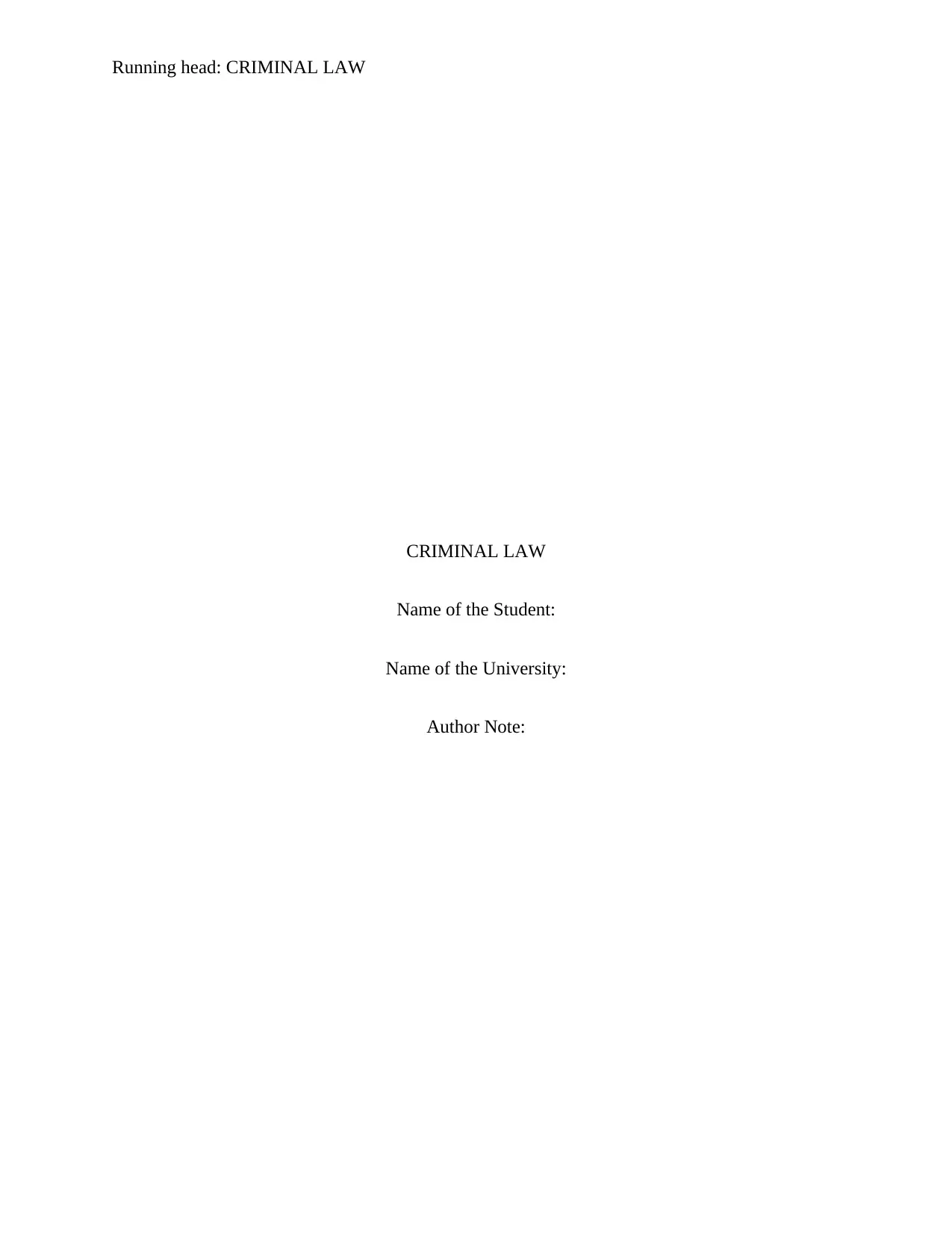
Running head: CRIMINAL LAW
CRIMINAL LAW
Name of the Student:
Name of the University:
Author Note:
CRIMINAL LAW
Name of the Student:
Name of the University:
Author Note:
Paraphrase This Document
Need a fresh take? Get an instant paraphrase of this document with our AI Paraphraser
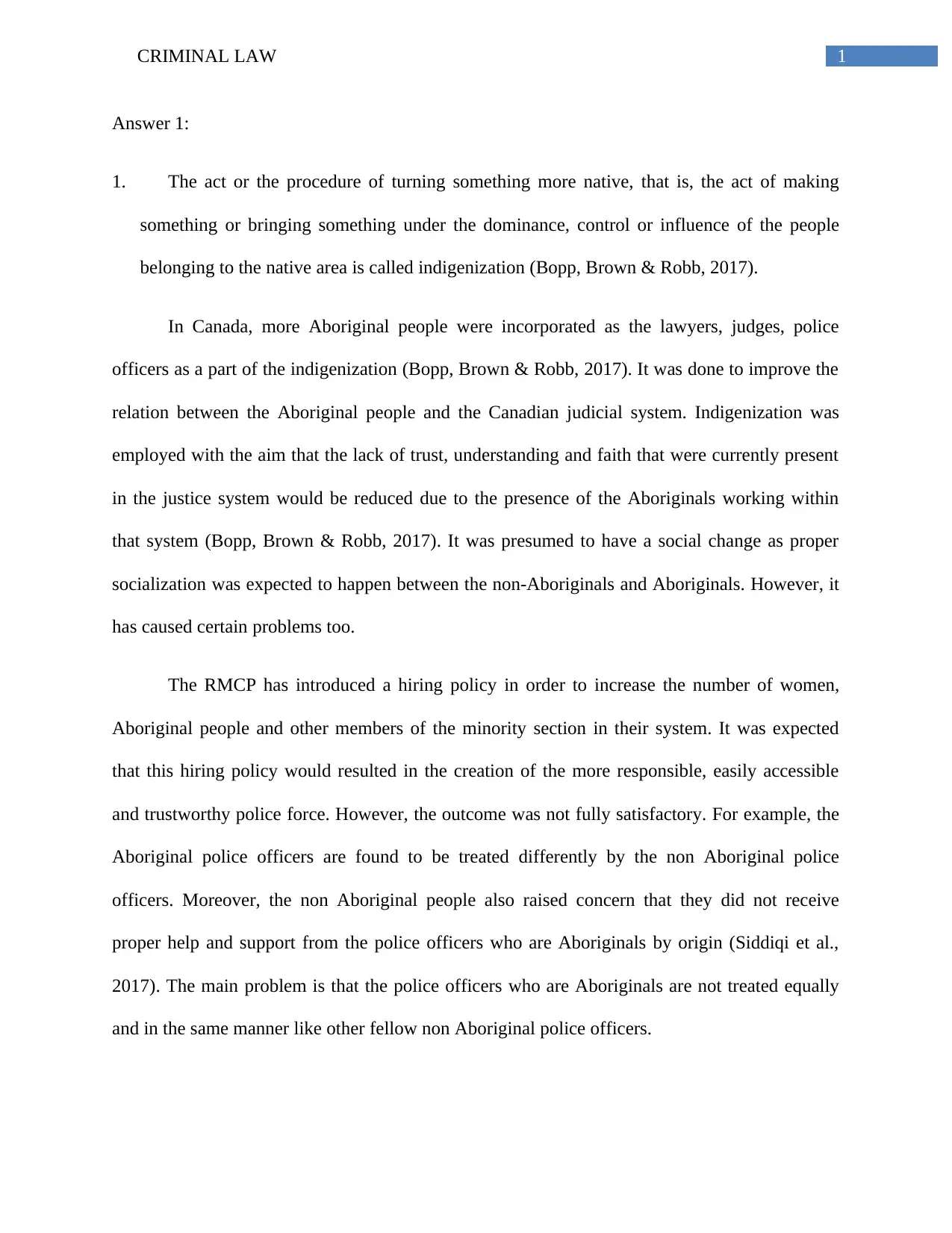
1CRIMINAL LAW
Answer 1:
1. The act or the procedure of turning something more native, that is, the act of making
something or bringing something under the dominance, control or influence of the people
belonging to the native area is called indigenization (Bopp, Brown & Robb, 2017).
In Canada, more Aboriginal people were incorporated as the lawyers, judges, police
officers as a part of the indigenization (Bopp, Brown & Robb, 2017). It was done to improve the
relation between the Aboriginal people and the Canadian judicial system. Indigenization was
employed with the aim that the lack of trust, understanding and faith that were currently present
in the justice system would be reduced due to the presence of the Aboriginals working within
that system (Bopp, Brown & Robb, 2017). It was presumed to have a social change as proper
socialization was expected to happen between the non-Aboriginals and Aboriginals. However, it
has caused certain problems too.
The RMCP has introduced a hiring policy in order to increase the number of women,
Aboriginal people and other members of the minority section in their system. It was expected
that this hiring policy would resulted in the creation of the more responsible, easily accessible
and trustworthy police force. However, the outcome was not fully satisfactory. For example, the
Aboriginal police officers are found to be treated differently by the non Aboriginal police
officers. Moreover, the non Aboriginal people also raised concern that they did not receive
proper help and support from the police officers who are Aboriginals by origin (Siddiqi et al.,
2017). The main problem is that the police officers who are Aboriginals are not treated equally
and in the same manner like other fellow non Aboriginal police officers.
Answer 1:
1. The act or the procedure of turning something more native, that is, the act of making
something or bringing something under the dominance, control or influence of the people
belonging to the native area is called indigenization (Bopp, Brown & Robb, 2017).
In Canada, more Aboriginal people were incorporated as the lawyers, judges, police
officers as a part of the indigenization (Bopp, Brown & Robb, 2017). It was done to improve the
relation between the Aboriginal people and the Canadian judicial system. Indigenization was
employed with the aim that the lack of trust, understanding and faith that were currently present
in the justice system would be reduced due to the presence of the Aboriginals working within
that system (Bopp, Brown & Robb, 2017). It was presumed to have a social change as proper
socialization was expected to happen between the non-Aboriginals and Aboriginals. However, it
has caused certain problems too.
The RMCP has introduced a hiring policy in order to increase the number of women,
Aboriginal people and other members of the minority section in their system. It was expected
that this hiring policy would resulted in the creation of the more responsible, easily accessible
and trustworthy police force. However, the outcome was not fully satisfactory. For example, the
Aboriginal police officers are found to be treated differently by the non Aboriginal police
officers. Moreover, the non Aboriginal people also raised concern that they did not receive
proper help and support from the police officers who are Aboriginals by origin (Siddiqi et al.,
2017). The main problem is that the police officers who are Aboriginals are not treated equally
and in the same manner like other fellow non Aboriginal police officers.
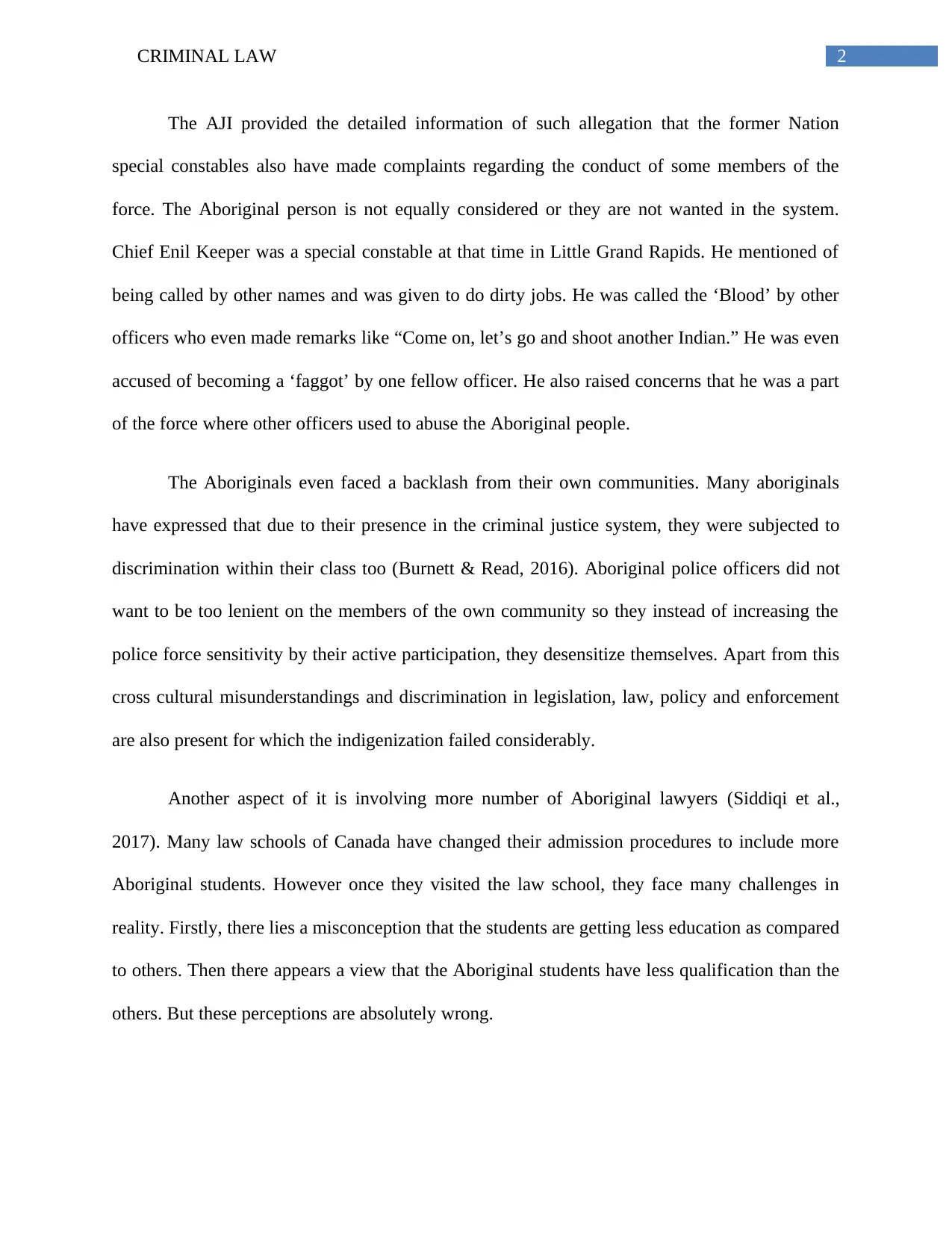
2CRIMINAL LAW
The AJI provided the detailed information of such allegation that the former Nation
special constables also have made complaints regarding the conduct of some members of the
force. The Aboriginal person is not equally considered or they are not wanted in the system.
Chief Enil Keeper was a special constable at that time in Little Grand Rapids. He mentioned of
being called by other names and was given to do dirty jobs. He was called the ‘Blood’ by other
officers who even made remarks like “Come on, let’s go and shoot another Indian.” He was even
accused of becoming a ‘faggot’ by one fellow officer. He also raised concerns that he was a part
of the force where other officers used to abuse the Aboriginal people.
The Aboriginals even faced a backlash from their own communities. Many aboriginals
have expressed that due to their presence in the criminal justice system, they were subjected to
discrimination within their class too (Burnett & Read, 2016). Aboriginal police officers did not
want to be too lenient on the members of the own community so they instead of increasing the
police force sensitivity by their active participation, they desensitize themselves. Apart from this
cross cultural misunderstandings and discrimination in legislation, law, policy and enforcement
are also present for which the indigenization failed considerably.
Another aspect of it is involving more number of Aboriginal lawyers (Siddiqi et al.,
2017). Many law schools of Canada have changed their admission procedures to include more
Aboriginal students. However once they visited the law school, they face many challenges in
reality. Firstly, there lies a misconception that the students are getting less education as compared
to others. Then there appears a view that the Aboriginal students have less qualification than the
others. But these perceptions are absolutely wrong.
The AJI provided the detailed information of such allegation that the former Nation
special constables also have made complaints regarding the conduct of some members of the
force. The Aboriginal person is not equally considered or they are not wanted in the system.
Chief Enil Keeper was a special constable at that time in Little Grand Rapids. He mentioned of
being called by other names and was given to do dirty jobs. He was called the ‘Blood’ by other
officers who even made remarks like “Come on, let’s go and shoot another Indian.” He was even
accused of becoming a ‘faggot’ by one fellow officer. He also raised concerns that he was a part
of the force where other officers used to abuse the Aboriginal people.
The Aboriginals even faced a backlash from their own communities. Many aboriginals
have expressed that due to their presence in the criminal justice system, they were subjected to
discrimination within their class too (Burnett & Read, 2016). Aboriginal police officers did not
want to be too lenient on the members of the own community so they instead of increasing the
police force sensitivity by their active participation, they desensitize themselves. Apart from this
cross cultural misunderstandings and discrimination in legislation, law, policy and enforcement
are also present for which the indigenization failed considerably.
Another aspect of it is involving more number of Aboriginal lawyers (Siddiqi et al.,
2017). Many law schools of Canada have changed their admission procedures to include more
Aboriginal students. However once they visited the law school, they face many challenges in
reality. Firstly, there lies a misconception that the students are getting less education as compared
to others. Then there appears a view that the Aboriginal students have less qualification than the
others. But these perceptions are absolutely wrong.
⊘ This is a preview!⊘
Do you want full access?
Subscribe today to unlock all pages.

Trusted by 1+ million students worldwide
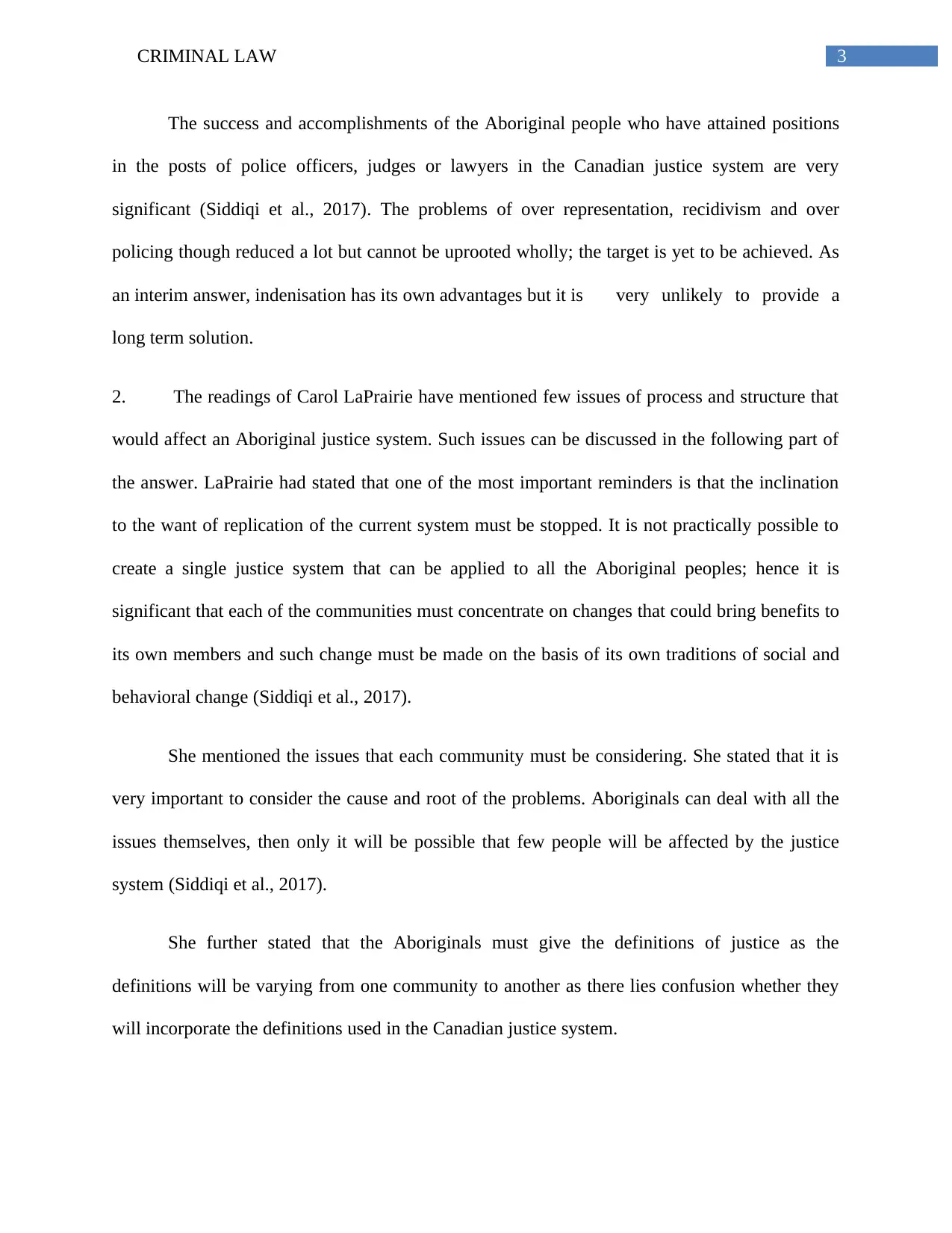
3CRIMINAL LAW
The success and accomplishments of the Aboriginal people who have attained positions
in the posts of police officers, judges or lawyers in the Canadian justice system are very
significant (Siddiqi et al., 2017). The problems of over representation, recidivism and over
policing though reduced a lot but cannot be uprooted wholly; the target is yet to be achieved. As
an interim answer, indenisation has its own advantages but it is very unlikely to provide a
long term solution.
2. The readings of Carol LaPrairie have mentioned few issues of process and structure that
would affect an Aboriginal justice system. Such issues can be discussed in the following part of
the answer. LaPrairie had stated that one of the most important reminders is that the inclination
to the want of replication of the current system must be stopped. It is not practically possible to
create a single justice system that can be applied to all the Aboriginal peoples; hence it is
significant that each of the communities must concentrate on changes that could bring benefits to
its own members and such change must be made on the basis of its own traditions of social and
behavioral change (Siddiqi et al., 2017).
She mentioned the issues that each community must be considering. She stated that it is
very important to consider the cause and root of the problems. Aboriginals can deal with all the
issues themselves, then only it will be possible that few people will be affected by the justice
system (Siddiqi et al., 2017).
She further stated that the Aboriginals must give the definitions of justice as the
definitions will be varying from one community to another as there lies confusion whether they
will incorporate the definitions used in the Canadian justice system.
The success and accomplishments of the Aboriginal people who have attained positions
in the posts of police officers, judges or lawyers in the Canadian justice system are very
significant (Siddiqi et al., 2017). The problems of over representation, recidivism and over
policing though reduced a lot but cannot be uprooted wholly; the target is yet to be achieved. As
an interim answer, indenisation has its own advantages but it is very unlikely to provide a
long term solution.
2. The readings of Carol LaPrairie have mentioned few issues of process and structure that
would affect an Aboriginal justice system. Such issues can be discussed in the following part of
the answer. LaPrairie had stated that one of the most important reminders is that the inclination
to the want of replication of the current system must be stopped. It is not practically possible to
create a single justice system that can be applied to all the Aboriginal peoples; hence it is
significant that each of the communities must concentrate on changes that could bring benefits to
its own members and such change must be made on the basis of its own traditions of social and
behavioral change (Siddiqi et al., 2017).
She mentioned the issues that each community must be considering. She stated that it is
very important to consider the cause and root of the problems. Aboriginals can deal with all the
issues themselves, then only it will be possible that few people will be affected by the justice
system (Siddiqi et al., 2017).
She further stated that the Aboriginals must give the definitions of justice as the
definitions will be varying from one community to another as there lies confusion whether they
will incorporate the definitions used in the Canadian justice system.
Paraphrase This Document
Need a fresh take? Get an instant paraphrase of this document with our AI Paraphraser
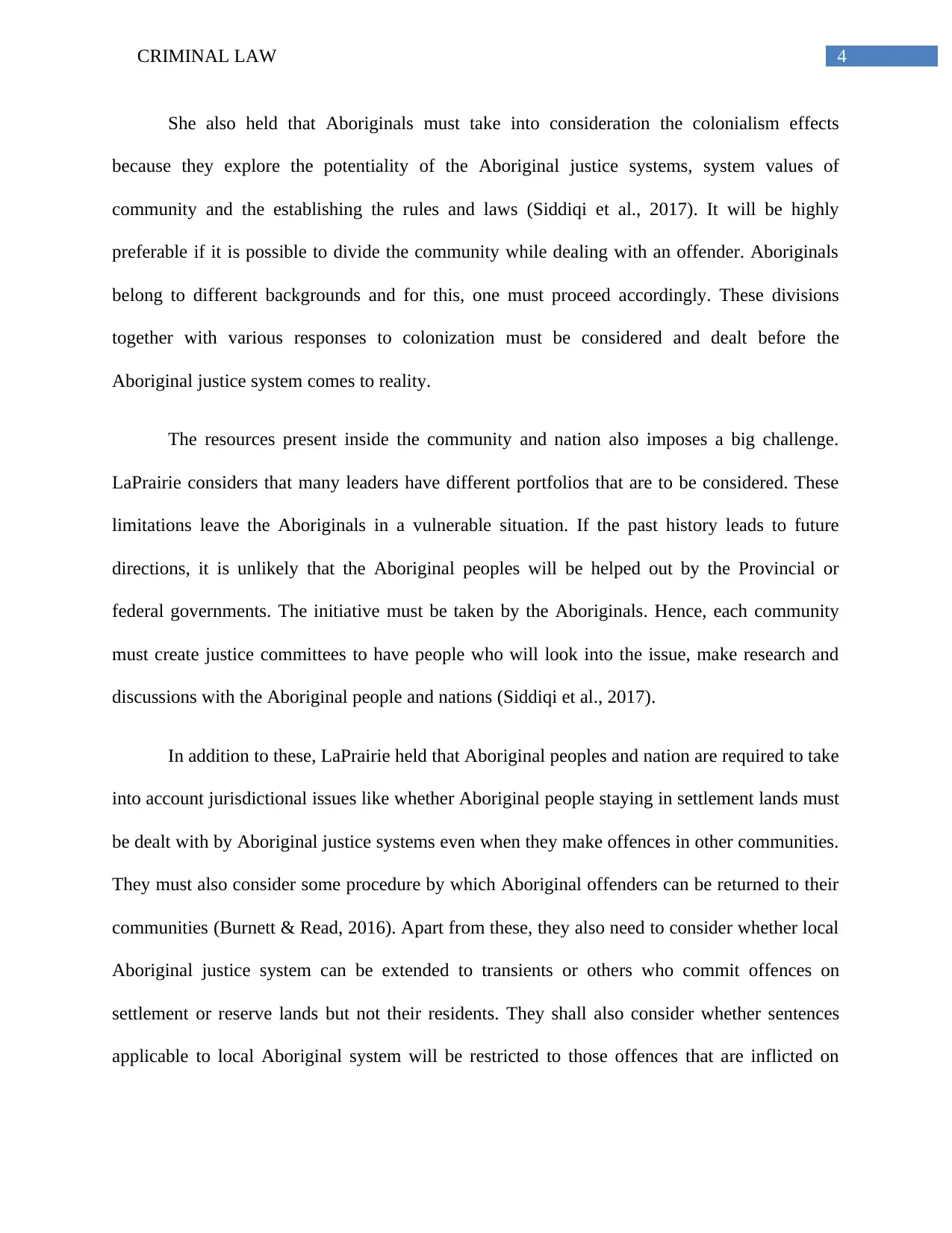
4CRIMINAL LAW
She also held that Aboriginals must take into consideration the colonialism effects
because they explore the potentiality of the Aboriginal justice systems, system values of
community and the establishing the rules and laws (Siddiqi et al., 2017). It will be highly
preferable if it is possible to divide the community while dealing with an offender. Aboriginals
belong to different backgrounds and for this, one must proceed accordingly. These divisions
together with various responses to colonization must be considered and dealt before the
Aboriginal justice system comes to reality.
The resources present inside the community and nation also imposes a big challenge.
LaPrairie considers that many leaders have different portfolios that are to be considered. These
limitations leave the Aboriginals in a vulnerable situation. If the past history leads to future
directions, it is unlikely that the Aboriginal peoples will be helped out by the Provincial or
federal governments. The initiative must be taken by the Aboriginals. Hence, each community
must create justice committees to have people who will look into the issue, make research and
discussions with the Aboriginal people and nations (Siddiqi et al., 2017).
In addition to these, LaPrairie held that Aboriginal peoples and nation are required to take
into account jurisdictional issues like whether Aboriginal people staying in settlement lands must
be dealt with by Aboriginal justice systems even when they make offences in other communities.
They must also consider some procedure by which Aboriginal offenders can be returned to their
communities (Burnett & Read, 2016). Apart from these, they also need to consider whether local
Aboriginal justice system can be extended to transients or others who commit offences on
settlement or reserve lands but not their residents. They shall also consider whether sentences
applicable to local Aboriginal system will be restricted to those offences that are inflicted on
She also held that Aboriginals must take into consideration the colonialism effects
because they explore the potentiality of the Aboriginal justice systems, system values of
community and the establishing the rules and laws (Siddiqi et al., 2017). It will be highly
preferable if it is possible to divide the community while dealing with an offender. Aboriginals
belong to different backgrounds and for this, one must proceed accordingly. These divisions
together with various responses to colonization must be considered and dealt before the
Aboriginal justice system comes to reality.
The resources present inside the community and nation also imposes a big challenge.
LaPrairie considers that many leaders have different portfolios that are to be considered. These
limitations leave the Aboriginals in a vulnerable situation. If the past history leads to future
directions, it is unlikely that the Aboriginal peoples will be helped out by the Provincial or
federal governments. The initiative must be taken by the Aboriginals. Hence, each community
must create justice committees to have people who will look into the issue, make research and
discussions with the Aboriginal people and nations (Siddiqi et al., 2017).
In addition to these, LaPrairie held that Aboriginal peoples and nation are required to take
into account jurisdictional issues like whether Aboriginal people staying in settlement lands must
be dealt with by Aboriginal justice systems even when they make offences in other communities.
They must also consider some procedure by which Aboriginal offenders can be returned to their
communities (Burnett & Read, 2016). Apart from these, they also need to consider whether local
Aboriginal justice system can be extended to transients or others who commit offences on
settlement or reserve lands but not their residents. They shall also consider whether sentences
applicable to local Aboriginal system will be restricted to those offences that are inflicted on
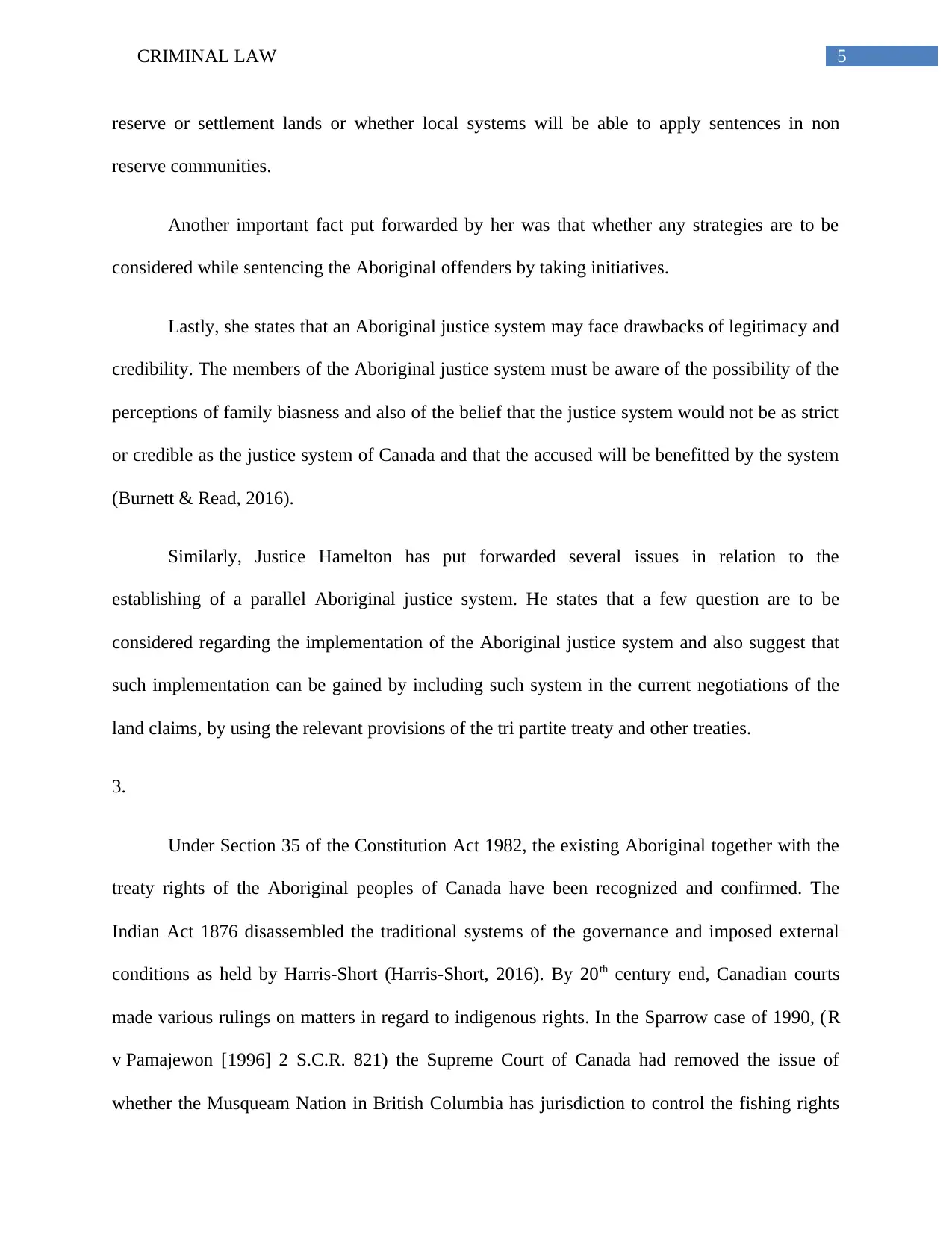
5CRIMINAL LAW
reserve or settlement lands or whether local systems will be able to apply sentences in non
reserve communities.
Another important fact put forwarded by her was that whether any strategies are to be
considered while sentencing the Aboriginal offenders by taking initiatives.
Lastly, she states that an Aboriginal justice system may face drawbacks of legitimacy and
credibility. The members of the Aboriginal justice system must be aware of the possibility of the
perceptions of family biasness and also of the belief that the justice system would not be as strict
or credible as the justice system of Canada and that the accused will be benefitted by the system
(Burnett & Read, 2016).
Similarly, Justice Hamelton has put forwarded several issues in relation to the
establishing of a parallel Aboriginal justice system. He states that a few question are to be
considered regarding the implementation of the Aboriginal justice system and also suggest that
such implementation can be gained by including such system in the current negotiations of the
land claims, by using the relevant provisions of the tri partite treaty and other treaties.
3.
Under Section 35 of the Constitution Act 1982, the existing Aboriginal together with the
treaty rights of the Aboriginal peoples of Canada have been recognized and confirmed. The
Indian Act 1876 disassembled the traditional systems of the governance and imposed external
conditions as held by Harris-Short (Harris-Short, 2016). By 20th century end, Canadian courts
made various rulings on matters in regard to indigenous rights. In the Sparrow case of 1990, (R
v Pamajewon [1996] 2 S.C.R. 821) the Supreme Court of Canada had removed the issue of
whether the Musqueam Nation in British Columbia has jurisdiction to control the fishing rights
reserve or settlement lands or whether local systems will be able to apply sentences in non
reserve communities.
Another important fact put forwarded by her was that whether any strategies are to be
considered while sentencing the Aboriginal offenders by taking initiatives.
Lastly, she states that an Aboriginal justice system may face drawbacks of legitimacy and
credibility. The members of the Aboriginal justice system must be aware of the possibility of the
perceptions of family biasness and also of the belief that the justice system would not be as strict
or credible as the justice system of Canada and that the accused will be benefitted by the system
(Burnett & Read, 2016).
Similarly, Justice Hamelton has put forwarded several issues in relation to the
establishing of a parallel Aboriginal justice system. He states that a few question are to be
considered regarding the implementation of the Aboriginal justice system and also suggest that
such implementation can be gained by including such system in the current negotiations of the
land claims, by using the relevant provisions of the tri partite treaty and other treaties.
3.
Under Section 35 of the Constitution Act 1982, the existing Aboriginal together with the
treaty rights of the Aboriginal peoples of Canada have been recognized and confirmed. The
Indian Act 1876 disassembled the traditional systems of the governance and imposed external
conditions as held by Harris-Short (Harris-Short, 2016). By 20th century end, Canadian courts
made various rulings on matters in regard to indigenous rights. In the Sparrow case of 1990, (R
v Pamajewon [1996] 2 S.C.R. 821) the Supreme Court of Canada had removed the issue of
whether the Musqueam Nation in British Columbia has jurisdiction to control the fishing rights
⊘ This is a preview!⊘
Do you want full access?
Subscribe today to unlock all pages.

Trusted by 1+ million students worldwide
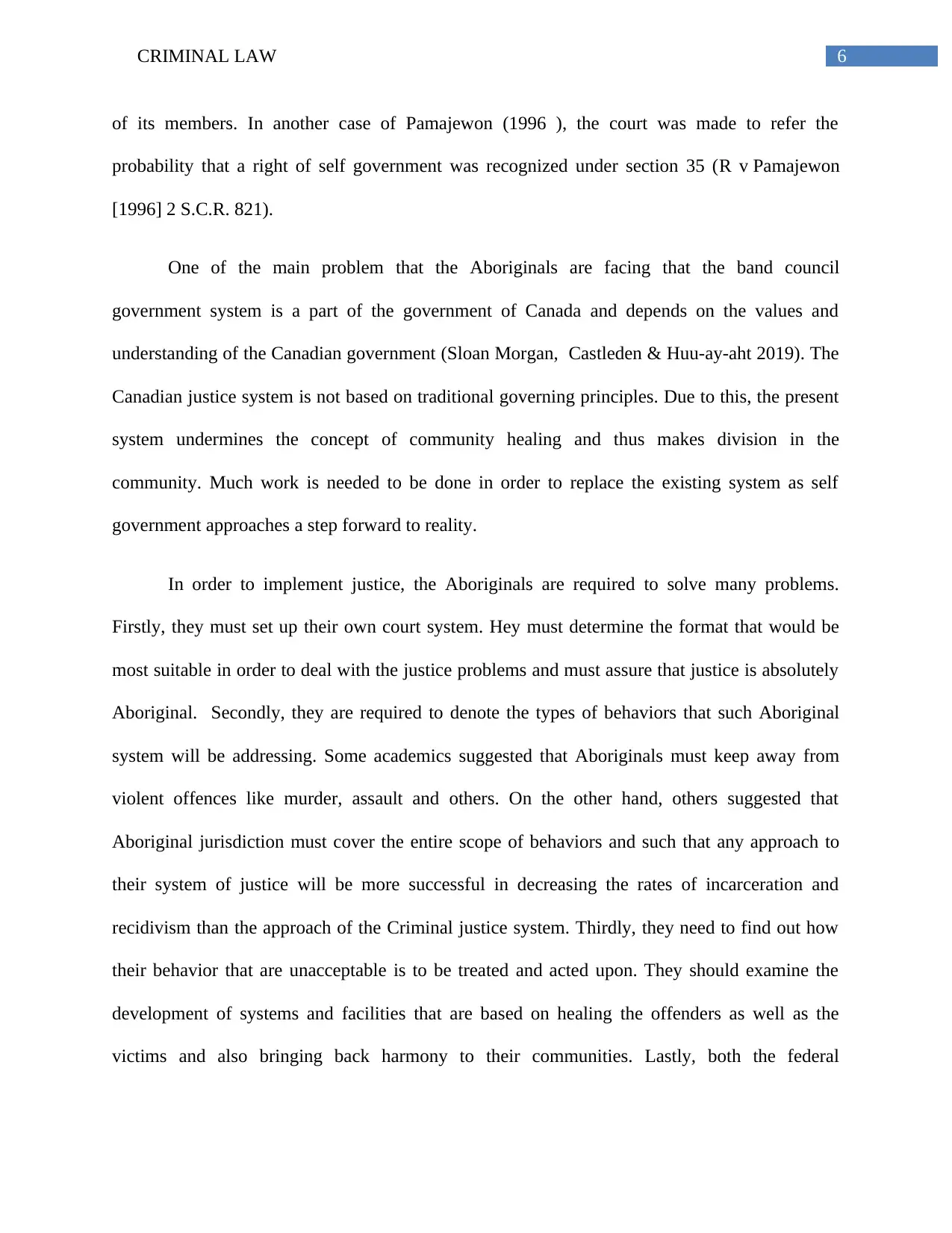
6CRIMINAL LAW
of its members. In another case of Pamajewon (1996 ), the court was made to refer the
probability that a right of self government was recognized under section 35 (R v Pamajewon
[1996] 2 S.C.R. 821).
One of the main problem that the Aboriginals are facing that the band council
government system is a part of the government of Canada and depends on the values and
understanding of the Canadian government (Sloan Morgan, Castleden & Huu‐ay‐aht 2019). The
Canadian justice system is not based on traditional governing principles. Due to this, the present
system undermines the concept of community healing and thus makes division in the
community. Much work is needed to be done in order to replace the existing system as self
government approaches a step forward to reality.
In order to implement justice, the Aboriginals are required to solve many problems.
Firstly, they must set up their own court system. Hey must determine the format that would be
most suitable in order to deal with the justice problems and must assure that justice is absolutely
Aboriginal. Secondly, they are required to denote the types of behaviors that such Aboriginal
system will be addressing. Some academics suggested that Aboriginals must keep away from
violent offences like murder, assault and others. On the other hand, others suggested that
Aboriginal jurisdiction must cover the entire scope of behaviors and such that any approach to
their system of justice will be more successful in decreasing the rates of incarceration and
recidivism than the approach of the Criminal justice system. Thirdly, they need to find out how
their behavior that are unacceptable is to be treated and acted upon. They should examine the
development of systems and facilities that are based on healing the offenders as well as the
victims and also bringing back harmony to their communities. Lastly, both the federal
of its members. In another case of Pamajewon (1996 ), the court was made to refer the
probability that a right of self government was recognized under section 35 (R v Pamajewon
[1996] 2 S.C.R. 821).
One of the main problem that the Aboriginals are facing that the band council
government system is a part of the government of Canada and depends on the values and
understanding of the Canadian government (Sloan Morgan, Castleden & Huu‐ay‐aht 2019). The
Canadian justice system is not based on traditional governing principles. Due to this, the present
system undermines the concept of community healing and thus makes division in the
community. Much work is needed to be done in order to replace the existing system as self
government approaches a step forward to reality.
In order to implement justice, the Aboriginals are required to solve many problems.
Firstly, they must set up their own court system. Hey must determine the format that would be
most suitable in order to deal with the justice problems and must assure that justice is absolutely
Aboriginal. Secondly, they are required to denote the types of behaviors that such Aboriginal
system will be addressing. Some academics suggested that Aboriginals must keep away from
violent offences like murder, assault and others. On the other hand, others suggested that
Aboriginal jurisdiction must cover the entire scope of behaviors and such that any approach to
their system of justice will be more successful in decreasing the rates of incarceration and
recidivism than the approach of the Criminal justice system. Thirdly, they need to find out how
their behavior that are unacceptable is to be treated and acted upon. They should examine the
development of systems and facilities that are based on healing the offenders as well as the
victims and also bringing back harmony to their communities. Lastly, both the federal
Paraphrase This Document
Need a fresh take? Get an instant paraphrase of this document with our AI Paraphraser
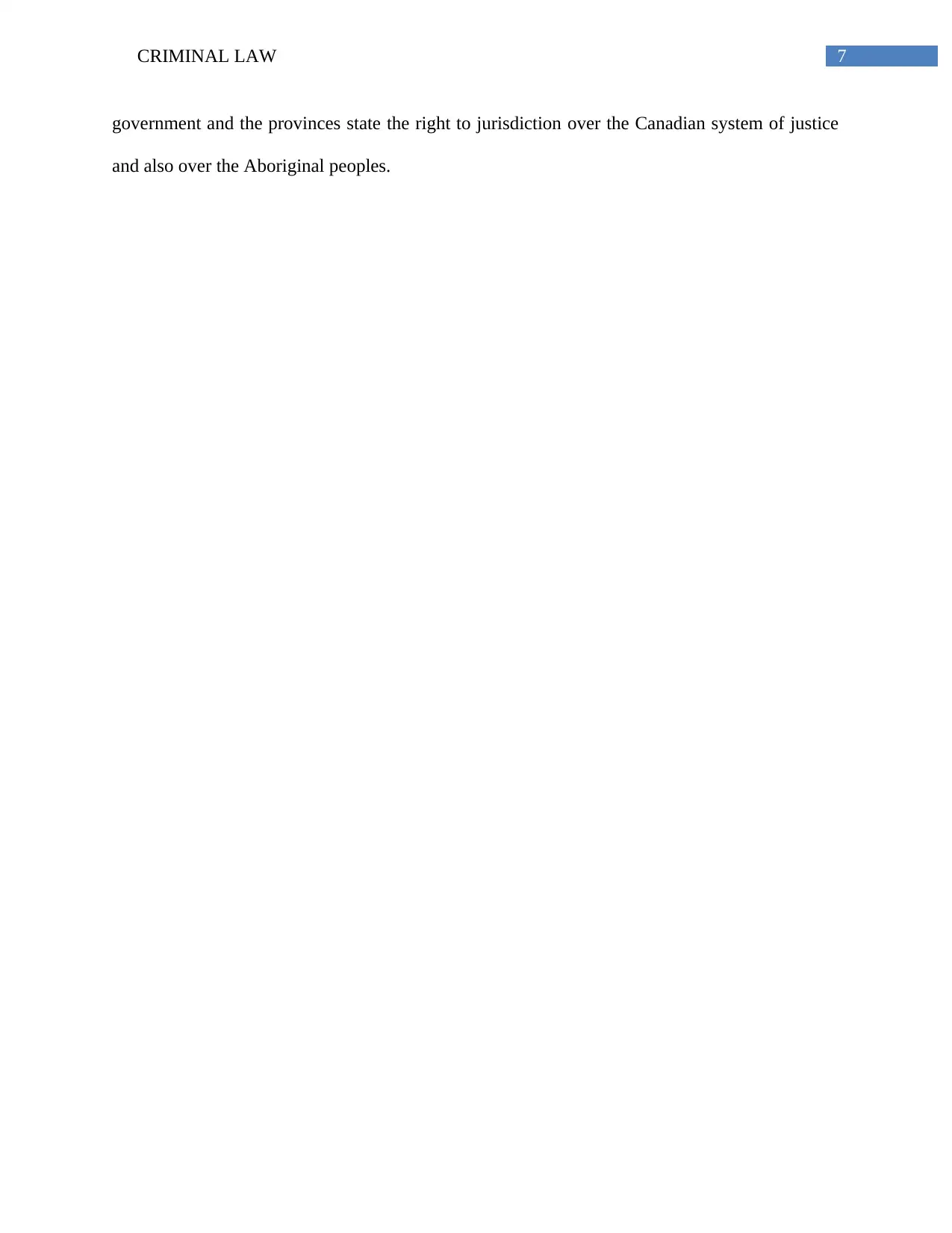
7CRIMINAL LAW
government and the provinces state the right to jurisdiction over the Canadian system of justice
and also over the Aboriginal peoples.
government and the provinces state the right to jurisdiction over the Canadian system of justice
and also over the Aboriginal peoples.
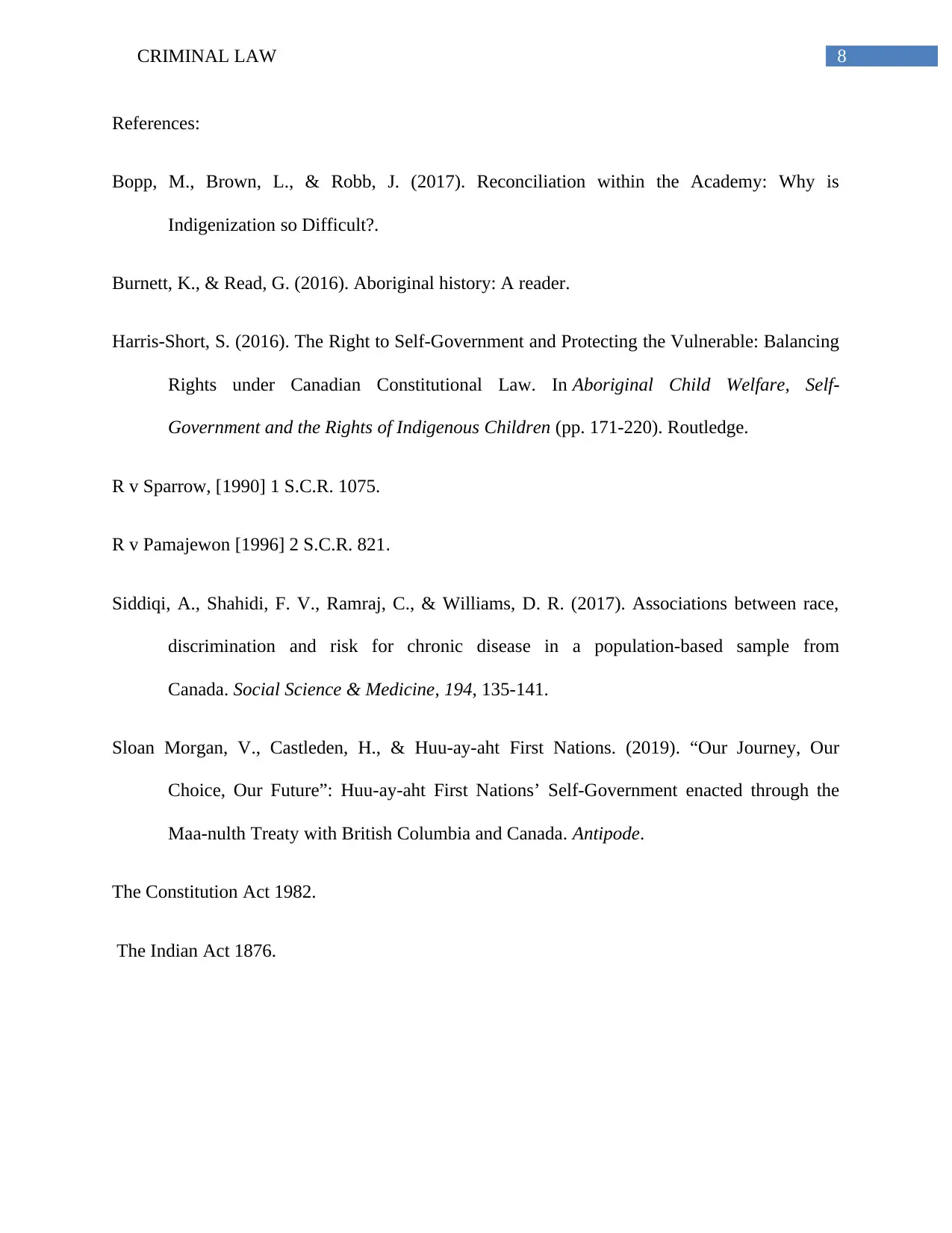
8CRIMINAL LAW
References:
Bopp, M., Brown, L., & Robb, J. (2017). Reconciliation within the Academy: Why is
Indigenization so Difficult?.
Burnett, K., & Read, G. (2016). Aboriginal history: A reader.
Harris-Short, S. (2016). The Right to Self-Government and Protecting the Vulnerable: Balancing
Rights under Canadian Constitutional Law. In Aboriginal Child Welfare, Self-
Government and the Rights of Indigenous Children (pp. 171-220). Routledge.
R v Sparrow, [1990] 1 S.C.R. 1075.
R v Pamajewon [1996] 2 S.C.R. 821.
Siddiqi, A., Shahidi, F. V., Ramraj, C., & Williams, D. R. (2017). Associations between race,
discrimination and risk for chronic disease in a population-based sample from
Canada. Social Science & Medicine, 194, 135-141.
Sloan Morgan, V., Castleden, H., & Huu‐ay‐aht First Nations. (2019). “Our Journey, Our
Choice, Our Future”: Huu‐ay‐aht First Nations’ Self‐Government enacted through the
Maa‐nulth Treaty with British Columbia and Canada. Antipode.
The Constitution Act 1982.
The Indian Act 1876.
References:
Bopp, M., Brown, L., & Robb, J. (2017). Reconciliation within the Academy: Why is
Indigenization so Difficult?.
Burnett, K., & Read, G. (2016). Aboriginal history: A reader.
Harris-Short, S. (2016). The Right to Self-Government and Protecting the Vulnerable: Balancing
Rights under Canadian Constitutional Law. In Aboriginal Child Welfare, Self-
Government and the Rights of Indigenous Children (pp. 171-220). Routledge.
R v Sparrow, [1990] 1 S.C.R. 1075.
R v Pamajewon [1996] 2 S.C.R. 821.
Siddiqi, A., Shahidi, F. V., Ramraj, C., & Williams, D. R. (2017). Associations between race,
discrimination and risk for chronic disease in a population-based sample from
Canada. Social Science & Medicine, 194, 135-141.
Sloan Morgan, V., Castleden, H., & Huu‐ay‐aht First Nations. (2019). “Our Journey, Our
Choice, Our Future”: Huu‐ay‐aht First Nations’ Self‐Government enacted through the
Maa‐nulth Treaty with British Columbia and Canada. Antipode.
The Constitution Act 1982.
The Indian Act 1876.
⊘ This is a preview!⊘
Do you want full access?
Subscribe today to unlock all pages.

Trusted by 1+ million students worldwide
1 out of 9
Related Documents
Your All-in-One AI-Powered Toolkit for Academic Success.
+13062052269
info@desklib.com
Available 24*7 on WhatsApp / Email
![[object Object]](/_next/static/media/star-bottom.7253800d.svg)
Unlock your academic potential
Copyright © 2020–2025 A2Z Services. All Rights Reserved. Developed and managed by ZUCOL.





